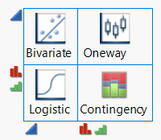- JMP will suspend normal business operations for our Winter Holiday beginning on Wednesday, Dec. 24, 2025, at 5:00 p.m. ET (2:00 p.m. ET for JMP Accounts Receivable).
Regular business hours will resume at 9:00 a.m. EST on Friday, Jan. 2, 2026. - We’re retiring the File Exchange at the end of this year. The JMP Marketplace is now your destination for add-ins and extensions.
- Subscribe to RSS Feed
- Mark Topic as New
- Mark Topic as Read
- Float this Topic for Current User
- Bookmark
- Subscribe
- Mute
- Printer Friendly Page
Discussions
Solve problems, and share tips and tricks with other JMP users.- JMP User Community
- :
- Discussions
- :
- Re: Bivariate analysis
- Mark as New
- Bookmark
- Subscribe
- Mute
- Subscribe to RSS Feed
- Get Direct Link
- Report Inappropriate Content
Bivariate analysis
Bonjour,
J'aimerai une confirmation sur l'analyse bivariée effectuée par JMP.
Lorsque seuls les paramètres X et Y sont entrés est-ce que l'analyse statistiques effectuée par la suite est de type paramétrique? Si oui est-ce qu'il est possible de faire une analyse de type non paramétrique? Comment procéder?
Merci d'avance
Marie
Accepted Solutions
- Mark as New
- Bookmark
- Subscribe
- Mute
- Subscribe to RSS Feed
- Get Direct Link
- Report Inappropriate Content
Re: Bivariate analysis
Fit Y by X, more specifically Bivariate, is performing standard least squares regression. Regression does not assume that your data be normally distributed. But it does assume that the residuals (or errors) be normally distributed. This distinction is important because the raw data will have signals in it that could prevent it from being normally distributed. The X or explanatory variable should remove the effect of the signals. What is left (the errors or residuals) need to be normally distributed in order for all of the statistical inferences of the regression to be valid. That is why a regression analysis should always include an examination of the residuals as well. Bivariate will allow you to perform the residual analysis.
If the residuals are not normally distributed, there are a few options. One is to transform your response so that the residuals can be normally distributed. The Bivariate report offers several options to transform your response. They can be found under Fit Special from the red pop up menu.
Another option is to use Fit Model and specify a Generalized Linear Model. That will allow you to specify the distribution response. A generalized linear model is more than I can get into here, but might be worth you looking into for whatever your problem is.
- Mark as New
- Bookmark
- Subscribe
- Mute
- Subscribe to RSS Feed
- Get Direct Link
- Report Inappropriate Content
Re: Bivariate analysis
Fit Y by X can perform four different types of analyses, depending on the modeling types of X and Y. Here are the different types of analyses based on the modeling types that are offered. This comes straight from the Fit Y by X dialog box:
Depending on the type of analysis, if the result is a parametric analysis, then the red triangle options will typically have a nonparametric option.
If you are more specific on what you are looking for, then the community may be able to provide more guidance.
- Mark as New
- Bookmark
- Subscribe
- Mute
- Subscribe to RSS Feed
- Get Direct Link
- Report Inappropriate Content
Re: Bivariate analysis
Bonjour Dan,
Merci pour votre réponse. En effet je me suis mal exprimée. Je connais l'analyse et les possibilité du fit Y by X en finction du type de données. Je veux faire une analyse bivariée sur des données continues mais qui ne suivent pas une loi normale.
Quand je lance le module fit Y by X je renseigne les champs Y et X et j'obtiens mon analyse. Mon pproblème est que je ne vois pas si JMP considère mes données comme paramétriques ou non paramétriques. Quand je clique sur le triangle rouge de l'analyse bivariée je ne peut pas sélectionné le type de mes données et je ne sais donc pas sur quoi se basent les statistiques obtenues.
Comment faire pour être sûre que l'analyse se fait bien en considérant que les données ne suivent pas une loi normale?
J'utilise JMP16.0.0
Merci pour votre aide
- Mark as New
- Bookmark
- Subscribe
- Mute
- Subscribe to RSS Feed
- Get Direct Link
- Report Inappropriate Content
Re: Bivariate analysis
Fit Y by X, more specifically Bivariate, is performing standard least squares regression. Regression does not assume that your data be normally distributed. But it does assume that the residuals (or errors) be normally distributed. This distinction is important because the raw data will have signals in it that could prevent it from being normally distributed. The X or explanatory variable should remove the effect of the signals. What is left (the errors or residuals) need to be normally distributed in order for all of the statistical inferences of the regression to be valid. That is why a regression analysis should always include an examination of the residuals as well. Bivariate will allow you to perform the residual analysis.
If the residuals are not normally distributed, there are a few options. One is to transform your response so that the residuals can be normally distributed. The Bivariate report offers several options to transform your response. They can be found under Fit Special from the red pop up menu.
Another option is to use Fit Model and specify a Generalized Linear Model. That will allow you to specify the distribution response. A generalized linear model is more than I can get into here, but might be worth you looking into for whatever your problem is.
- Mark as New
- Bookmark
- Subscribe
- Mute
- Subscribe to RSS Feed
- Get Direct Link
- Report Inappropriate Content
Re: Bivariate analysis
Thanks Dan,
All of this is very helpfull and will allow me to do the job I need to do!
I found and tested all your solutions and both of them give me my answer. I have a preference for the Fit Y by X then residuals analysis after fitting linear regression model!
Recommended Articles
- © 2025 JMP Statistical Discovery LLC. All Rights Reserved.
- Terms of Use
- Privacy Statement
- Contact Us


